10 Cool Optical Illusions and How They Work
Fact checked by Emily Swaim
Optical illusions, more appropriately known as visual illusions, involve visual deception. Due to the arrangement of images, the effect of colors, the impact of the light source, or other variables, a wide range of misleading visual effects can be seen.
Optical illusions can be fun and fascinating, but they can also tell us a great deal of information about how the brain and perceptual system function. There are countless optical illusions out there, but here is a sampling of some of the most fun and interesting.
Takeaway
Not everyone experiences visual illusions in the same way—which you may have discovered if you've ever struggled to see the hidden image in a single-image stereogram. For certain illusions, some people simply cannot see the effect and likely never will as one's perception of visual illusions tends to stay stable over time.
The Hermann Grid Optical Illusion

Rob Patrick Robpatrick / Flickr CC
Sometimes we see things that aren't there, and the Hermann Grid illusion is a great example. Notice how the dots at the center of each intersection seem to shift between white and gray?
Like many optical illusions, different theories have been proposed to explain exactly why this happens.
Lateral inhibition is often used to explain the Hermann grid illusion, but more recent evidence suggests this might not be why the illusion happens. This theory suggests that the brightness at the intersections forces retinal cells to adjust the intensity. Lateral inhibition happens when the excitation of surrounding neurons inhibits a neuron's response to a stimulus.
S1 simple-cell theory may be more helpful for understanding the illusion. Evidence supporting this theory includes the fact that the illusion is not dependent upon the size of the grid and still occurs when the contrast of the image is reversed. S1 simple-cell theory proposes that the illusion is caused by how S1-type simple cells in the primary visual cortex respond to certain visual stimuli.
The Spinning Dancer Optical Illusion
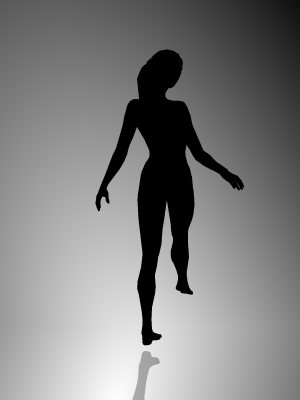
Also sometimes referred to as the silhouette illusion, this optical illusion involves determining whether the dancer is spinning to the right or left. Which is correct? Our brains can't tell.
Researchers suggest this optical illusion stems from bistable perception, where the ambiguous two-dimensional figure is perceived from two differing perspectives. Since there is no third dimension to provide important perceptual information, the brain attempts to fill in the space around the spinning figure.
Takeaway
This popular illusion has made the rounds on blogs and websites, supposedly as a test to determine if you are "left-brained or right-brained." In reality, the illusion occurs because our brains must attempt to construct space around the spinning figure.
The Ames Room Optical Illusion

Mosso - http://www.flickr.com/photos/39325045@N00/355613728/
Would you be surprised to learn that the two people in the image are actually the same size? Known as the Ames room illusion, this visual trick has been utilized in films such as The Lord of the Rings.
The Ames room illusion works due to the trapezoidal shape of the room. From the viewer's perspective, it looks like a square room, leading to the size distortion. The small figure is, in reality, standing at a greater distance than the larger figure.
The Ponzo Optical Illusion
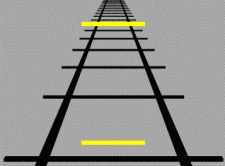
Wikimedia Commons
The Ponzo illusion involves placing two lines over an illustration of a railroad track. Which line is longer? In reality, they are exactly the same length.
This optical illusion occurs because people view the scene from a linear perspective. Since the vertical lines look like they are getting closer together, the viewer interprets the top line as further off in the distance.
Takeaway
When you look off into the distance, objects seem closer together as they become further away. For example, the outside borders of a road or railroad appear to converge as they recede into the distance.
The Zöllner Optical Illusion
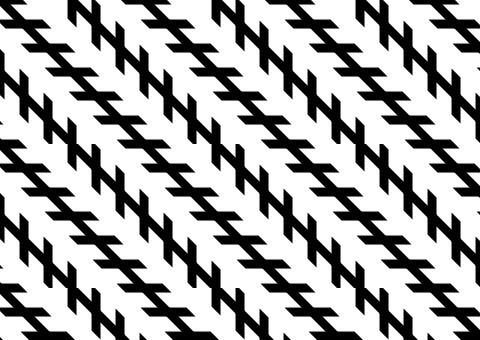
Fibonacci / Wikimedia Commons
Sometimes the background of an image can interfere with how the brain interprets the image itself. This is the case with the Zöllner illusion.
This illusion may occur due to the angle of the shorter lines compared to the long lines. This causes the brain to perceive depth where there is none.
Takeaway
This is one optical illusion that can make you start to feel slightly queasy if you stare at it for too long!
The Kanizsa Triangle Optical Illusion
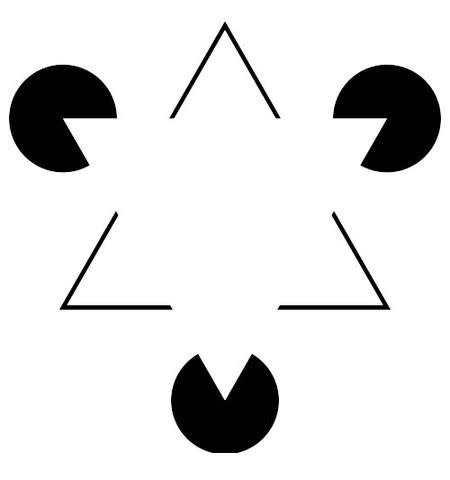
Wikimedia Commons
The Kanizsa triangle is a visual illusion in which the viewer perceives a triangle that does not exist. It is created by the brain filling in gaps in order to perceive a more complete whole.
According to the Gestalt law of closure, we tend to see objects close together as a related group. In the case of the Kanizsa triangle, we even see contour lines that do not exist and ignore gaps to form a cohesive image.
The Müller-Lyer Optical Illusion
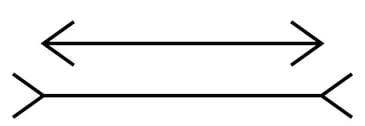
Fibonacci / Wikimedia Commons
Here's a classic optical illusion that still manages to stump a lot of people. Which line is longer? Both are the same length.
This phenomenon is known as the Müller-Lyer Illusion. A few different explanations have been proposed to explain how it works.
One theory suggests that the brain misapplies information about size consistency and scaling. This ability allows people to judge size in relation to distance but, when applied to a two-dimensional field, leads to errors.
Another theory proposes that depth cues related to the direction of the line shafts lead to misperceptions about line lengths. Depending on whether the shafts are facing inward or outward, the overall length of the figure may also contribute to interpretations of line length.
The Moon Optical Illusion

If you've ever spent any time gazing up at the night sky, you've probably noticed the moon illusion, in which the moon looks bigger on the horizon than it does higher in the sky. Why does this happen?
Many theories have been proposed, although there is no universally agreed-upon explanation. Judgments of distance can be influenced by how the moon appears in relation to figures in the foreground.
Takeaway
Other factors can also influence the illusion, including the color of the moon and the presence of atmospheric haze.
The Lilac Chaser Optical Illusion

TotoBaggins / Wikimedia Commons
In the lilac chaser illusion, the viewer observes several different visual effects over the span of about 30 seconds. First described in 2005, the illusion is caused by several different factors, including negative afterimages and what is known as Troxler fading.
An afterimage can occur when you stare at something for a long period. When you move your eyes or the object suddenly disappears, you may briefly continue to see a version of the image.
Troxler fading is when objects in your peripheral vision become blurred and disappear if you stare at a fixed spot for some time.
The Negative Picture Optical Illusion
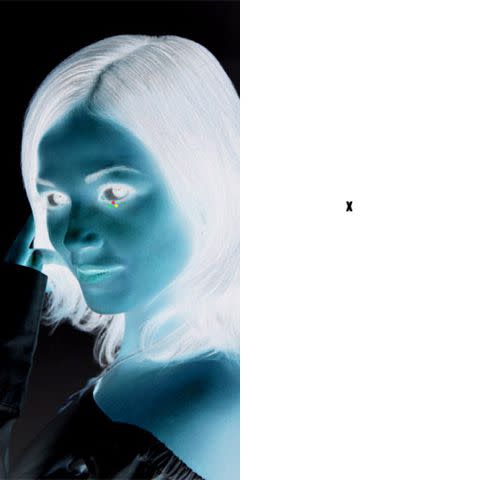
geloo, modified by Kendra Cherry
The negative picture illusion is an interesting example of how negative afterimages can produce a startling visual illusion. In the negative photo illusion, your brain and visual system essentially take a negative image and turn it into a full-color photo.
Takeaway
You can experience this illusion by staring at the image of the face for 30 seconds to a minute, then shift your focus to look at the X at the center of the blank white image and blink several times.
This optical illusion works because photoreceptors in the eye become overstimulated and fatigued from staring at the image. Because they lose sensitivity, you end up seeing negative afterimage briefly when you move your eyes.
Takeaways
These 10 optical illusions are just a sampling of the different visual illusions that exist. Such illusions can be fun and interesting, but they can also be a helpful way to understand some of the different ways that the brain and visual system work.
Frequently Asked Questions
What does an optical illusion do?
An optical illusion involves tricking your vision by taking advantage of how the eyes and brain work together to interpret the visual stimuli in our environment. Such illusions can be helpful for learning more about how the brain works.
What are the 3 main optical illusions?
The three main types of optical illusions are physiological illusions, cognitive illusions, and literal illusions.
Physiological illusions occur due to how the image affects the sensory capabilities of the eyes and brain.
Cognitive illusions rely on the brain making inferences or interpretations about what the eyes perceive.
Literal illusions are when two images are combined so that more than one image may be perceived.
What are the 5 types of illusions?
In addition to optical illusions, there are also a number of other different types of illusions that people may experience. These include auditory illusions, sensory illusions, olfactory illusions, and tactile illusions.
Read the original article on Verywell Mind.

 money
money 